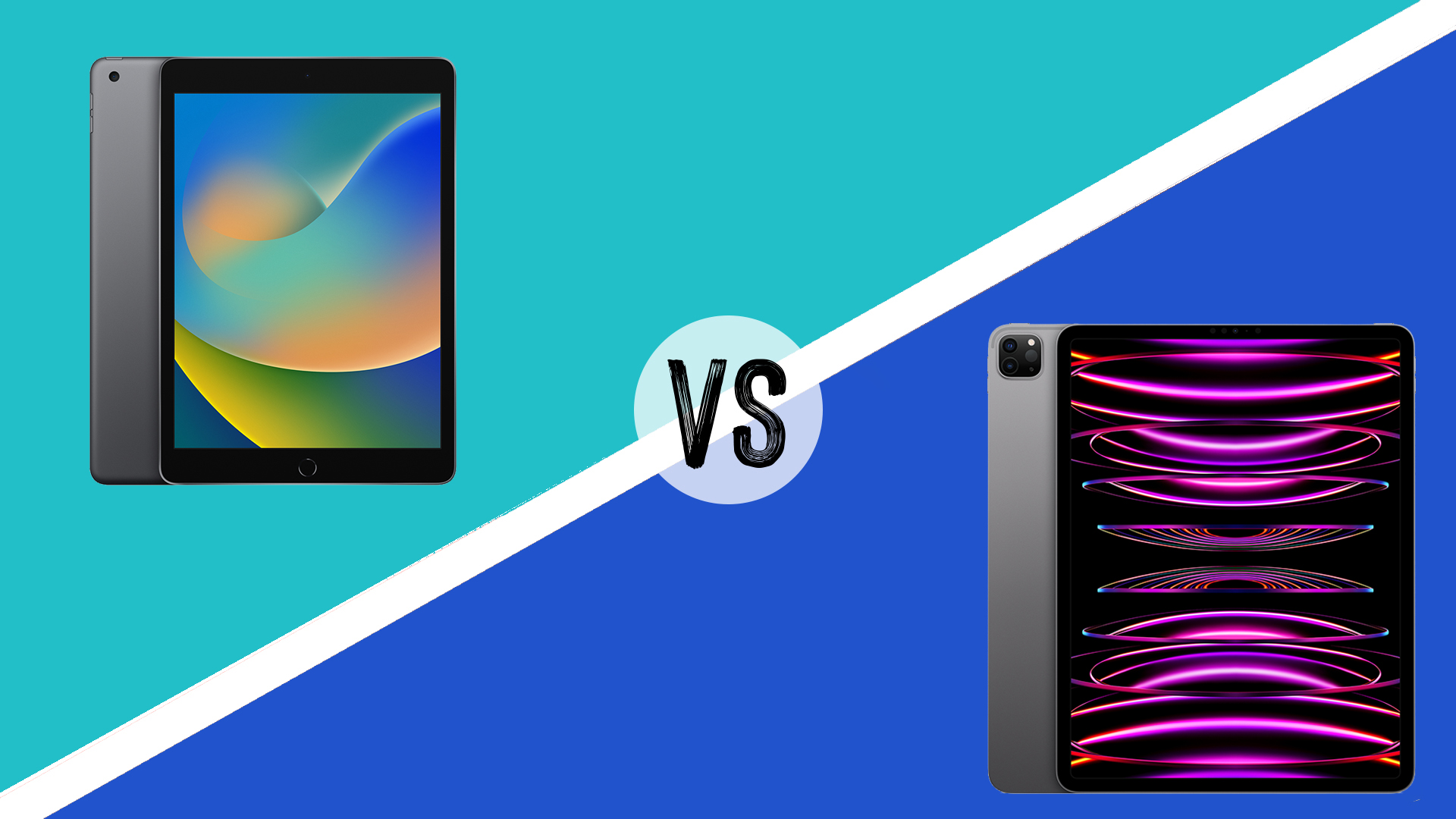
iPad vs iPad Pro is a decision you may be facing if you're in the market for a new tablet. Apple's iPad range now comprises four general models: the basic iPad, the iPad Air, iPad mini and iPad Pro, and the choice is complicated even further in these are each available in different configurations, and even in different sizes in some cases (see our full iPad generations list to see all the options).
In this guide, we'll specifically compare the two extremes of the range: the entry-level 10.2-inch iPad released in 2021 and the M2-powered iPad Pros released in 2022 (note that while no new iPads were released in 2023, we're expecting new models to be released in 2024). Although iPad vs iPad Pro may look relatively similar, and they use the same operating system, iPad OS, the two devices are words apart in terms of price and specs.
In the guide below we compare their design, power, performance and price with a particular focus on their potential for creative work to help you decide if the basic iPad will do the job for you or if you'll need a Pro. Don't forget to check out the best iPad Pro deals, and the best iPad mini prices, if you're on the look out for your next Apple tablet.
iPad vs iPad Pro: design
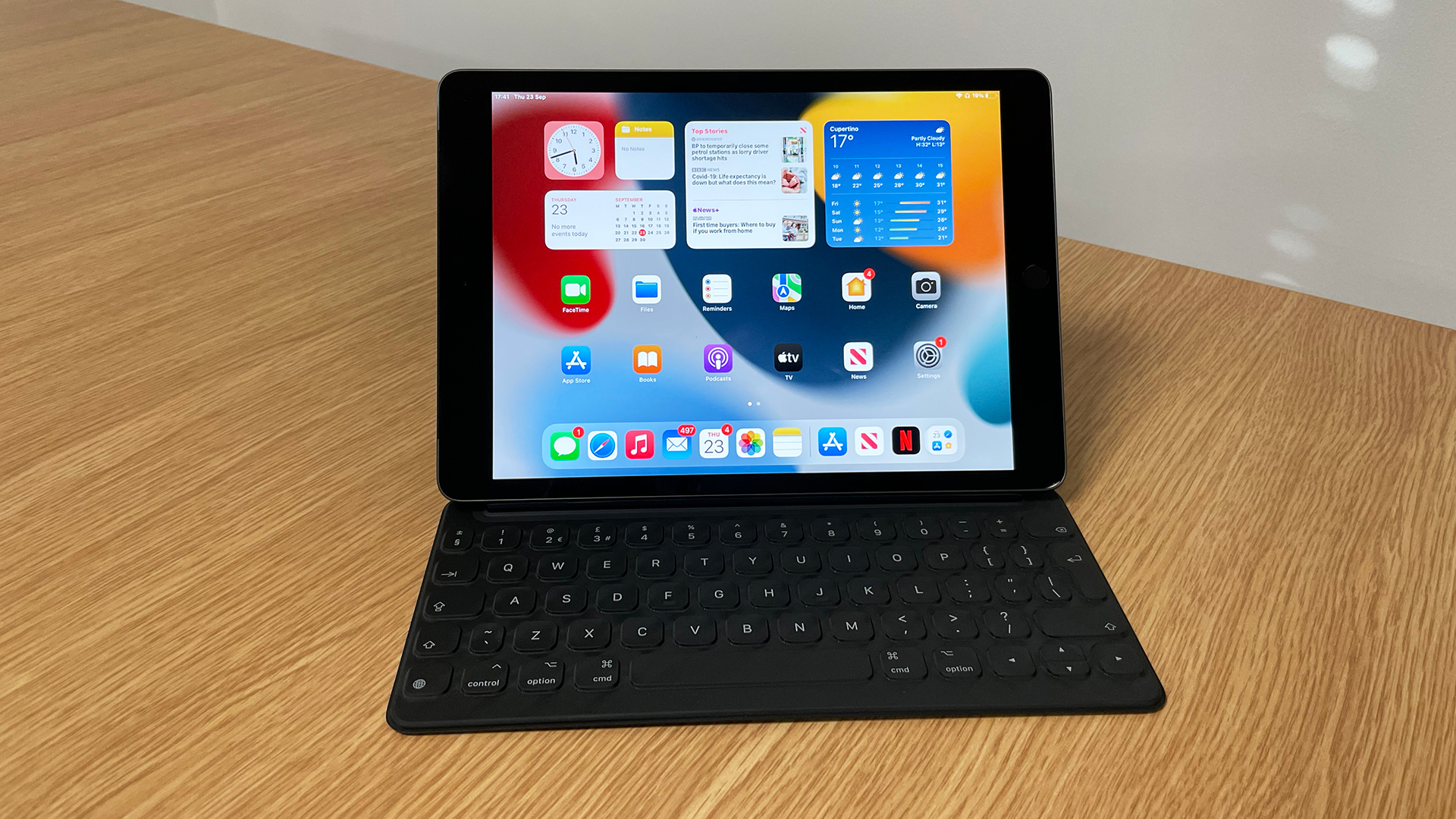
The cheapest iPad's design harks back to the first iPad and is starting to look a little dated, with quite sizeable bezels and a round Home button below the screen when you hold it vertical. It no longer looks very cutting edge, but the design does have its advantages – it's easy to hold and pass around something that has a fairly large bezel without moving something on the screen or smudging up the display. Also, the button-based system for going home is easily understood and controlled by kids, which makes the basic iPad a good option as a tablet for all the family to use.
Of course, it's still Apple, so even though it's looking a little dated, it still has a premium feel. It comes in three colours: Silver, Space Grey and Gold. The front is all a single piece of glass except for the button, and it has an aluminium back and sides. At 7.5mm thick, it feels perfectly svelte. There's a forward-facing camera in the top bezel, and a rear camera that's flush with the case. At the bottom (if held in portrait) are the speakers and a Lightning port for charging and connectivity. At the top is a Sleep/Wake button and a 3.5mm jack this is the only current iPad that still features one of these). On the right are two volume buttons.
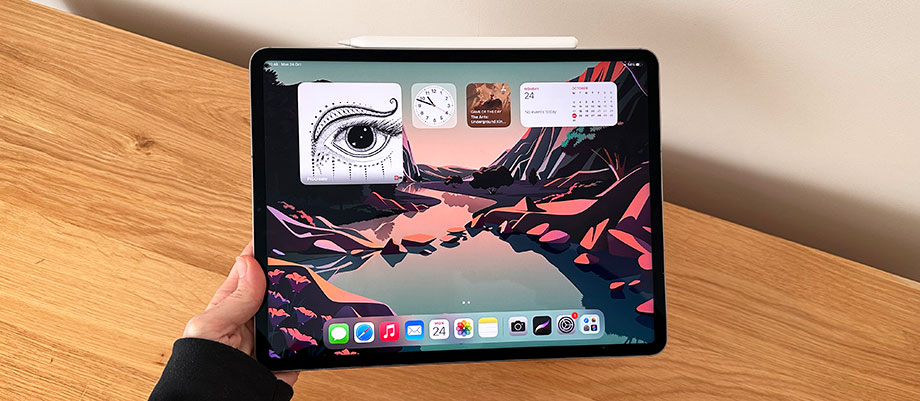
The iPad Pro has a sleeker-looking design, with slim equally sized bezels around the screen, and the display itself has rounded corners that match the case. There's also no Home button taking up space on the front.
Whereas the sides and back of the cheaper iPad curve into one another, the iPad Pro is all flat surfaces and right angles. This has a practical purpose in that it gives the Apple Pencil 2 a surface to magnetically connect to. It also looks pretty stark and cool. Again, it's all glass at the front, while the back and sides are aluminium. The camera module sticks out of the back a little, to provide the lenses with more space to work. On the front is a forward camera as well as a Face ID 3D scanning system, both hidden within the bezel.
The iPad Pro comes in two different sizes: 11-inch and 12.9-inch (both referring to the size of the screen, of course). The 11-inch model is just 5.9mm thick, making it feel ultra slim and portable. The larger version is 6.4mm thick. They come in Silver or Space Grey only.
Both versions have a proper stereo speaker system, with grilles in all four corners. On one end is a USB-C port for connectivity and charging; on the other is the Sleep/Wake button, with volume controls on the side. There's no 3.5mm jack here.
Really, the design differences between iPad vs iPad Pro models don't make much difference to whether they're worth purchasing on their own. It's certainly nice to have a more modern-feeling design if you're paying for the more expensive models, but really its the feature encased within the iPad Pro design – including that upgraded Apple Pencil support – that might persuade you to upgrade.
iPad vs iPad Pro: Display

Both iPad and iPad Pro have high-res LCD displays in sizes that aren't a million miles from each other… but there are some big differences here. The basic iPad has a 10.2-inch screen with a resolution of 2,160 x 1,620, which is a perfectly sharp 264 pixels per inch.
For viewing photos, reading text and pretty much any use it's designed for, there's more than enough detail for most people.Its brightness is 500 nits, which again is pretty good. You shouldn't have a problem seeing it in most lighting conditions, and this is as bright – if not brighter – than many laptops or monitors. It's an IPS screen, so its viewing angles are pretty great. Colour reproduction is strong, and contrast is decent. All in all, It's a good screen for the price. It also supports the Apple Pencil 1.
The iPad Pro 11-inch takes it up a level. The resolution is 2388 x 1668, which is also 264ppi, but with a brightness of 600 nits, you get a noticeable extra burst of vibrancy, and the brighter screen cuts through reflections better (also helped by better lamination, which makes ti appear to be closer to the surface of the glass, and an extra anti-reflective coating. This all adds up to a big boost in visibility in bright conditions.
Colour coverage is also better, with support for the P3 colour gamut in the iPad Pro, a real boost for video work. Apple's True Tone tech is included here, which shifts the colour balance to match the ambient lighting of the room you're in, making it much more comfortable to read on in warm interior lighting, too (note that the upgraded 2022 10.9 inch version of the basic iPad also has True Tone).
A key thing for digital artists is that it's a 120Hz screen, whereas the cheap iPad is 60Hz only. This makes for a smoother experience when drawing on the tablet with a stylus. The screen updates 120 times per second instead of 60 times per second, which means marks appear more fluidly, making it easier to be accurate. It's a major upgrade for serious artists. And the iPad Pros support the improved Apple Pencil 2 instead of the first-gen Apple Pencil.
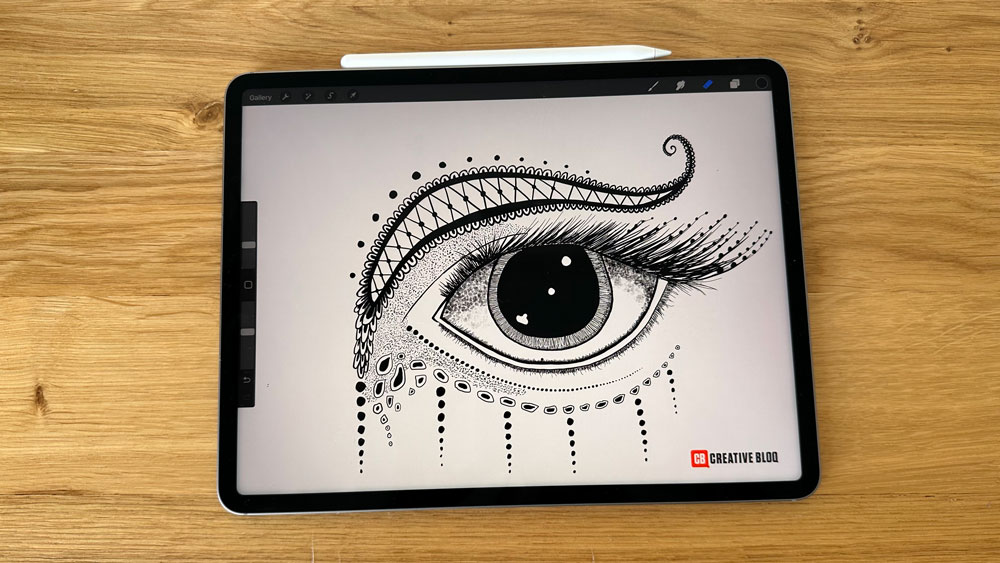
The iPad Pro 12.9 moves things into yet another gear, with some major upgrades even over its 11-inch sibling. Obviously the screen is larger, providing more space for work, (the 2732 x 2048 resolution is again 264ppi. But this model uses a mini-LED Liquid Retina XRD display instead of the regular LED backlights used in the basic iPad and the iPad Pro 11. This means there are thousands of tinier LEDs behind the screen, which can make it much brighter. In normal use, it's still 600 nits like the 11-inch version, but for HDR video or images, it can reach 1,000 nits fullscreen, and 1,600 nits for peak highlights in small areas.
This is beyond what many TVs can achieve, and it makes the 12.9-inch iPad Pro an incredible tool for video. And it's not just about brightness – there are 2,596 individual dimming zones for the backlight, so you can get impressive precision in darker areas of the screen. This also makes things like white icons stand out more clearly on dark backgrounds, and enhances the contrast of photos or other images. The refresh rate is boosted too, from 120Hz in the 11-inch device to 240Hz.
Basically, when it comes to screens: the cheap iPad is absolutely fine for most things, but the iPad Pro 11-inch is a major step up for creative work, and the iPad Pro 12.9-inch is in its own league, particularly for video.
iPad vs iPad Pro: Battery life

When it comes to battery life, iPad vs iPad Pro is a more even fight. You get roughly 10 hours of battery life in light use from all of these models, which has really been Apple's target for iPads since their inception. Of course, this depends on usage – playing games or really complex pro tasks will tax battery life more, and you could easily half that number with especially demanding work.
You might see this more keenly on the iPad Pros, with their ultra-powerful chips, since there's more likelihood that you'll be using them for more demanding work, like video editing, which will drain the battery more quickly. But for general browsing, you should get 10 hours easily. And both iPad and iPad Pro models hold their batteries between charges equally well – it takes days and days without use for an iPad to trickle down on standby.
iPad vs iPad Pro: Features
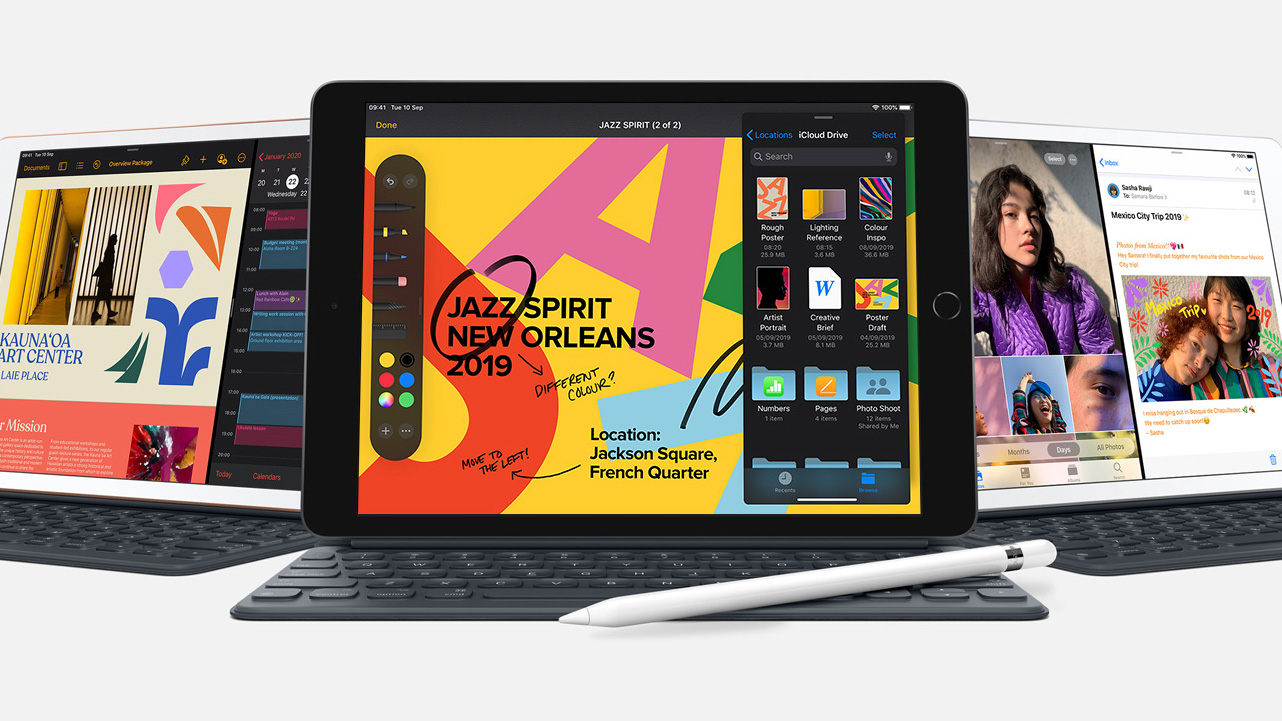
The iPad Pro models use a USB-C port for their connectivity, which doubles as a Thunderbolt 3 port. This means it offers flexibility for connecting devices, including things like external screens, microphones, storage and more. For certain pro uses, this can be a major, major benefit.
The cheaper iPad still uses Apple's own Lightning charging instead. This can connect to some accessories via adapter, but it's much more limited and uncertain, due to things like software inconsistencies and power outputs. The cheap iPad does have one potential connection benefit over the iPad Pro, though, and that's its built-in 3.5mm connection. For music-making, this is a fairly big deal, since it means none of the latency of Bluetooth headphones.
The iPad Pro works great with external DACs over its USB-C connection (we recommend the EarMen Sparrow), but musicians may wish it just had the 3.5mm jack, like the cheaper model.
Speaking of connectivity, both models include Wi-Fi and Bluetooth, but the iPad Pros feature Wi-Fi 6E (aka 802.11ax) while the iPad includes 802.11ac Wi-Fi 5. The iPad Pros also include Bluetooth 5.3, while the cheaper model is Bluetooth 4.2. All the models here have the option of including cellular connectivity too, but with the cheaper iPad that's 4G only, while the iPad Pros provide 5G.
We mentioned that the cheaper iPad supports the first-gen Apple Pencil. This pairs with the iPad and charges using the Lightning port (or a Lightning adapter that comes with the Pencil). This solution is best described as 'inelegant but functional'. The Apple Pencil itself works great, it's just weirdly awkward to charge.
The iPad Pros work with the Apple Pencil 2, which charges wirelessly from the iPad Pro's battery, by connecting magnetically to the side of the iPad. This is a vastly superior system, and the Pencil itself has several design and feature upgrades that provide a better experience for digital art (see our guide to the best iPad for drawing and how to draw on the iPad). All these models include Apple's 'Smart Connector' too, which is a very basic connection for keyboard cases to use.
The four speakers built into the iPad Pros are a massive, massive improvement over what's in the cheap iPad. On the basic model, the speakers are built into one end, so don't offer stereo when in landscape. Their detail and audio reproduction is no issue for the price, but they don't impress. The iPad Pros provide proper stereo with impressive separation and spatial effects, and they switch their configuration depending on which round you hold the iPad, so you get that stereo no matter how you hold it. It's also much louder and much fuller.
Similarly, the iPad Pro has a whole array of microphones with beam-forming tech, designed for video calls so that you sounds pristine and noise around you is reduced. The regular iPad's just has a couple of microphones with basic noise reduction.
iPad vs iPad Pro: Cameras
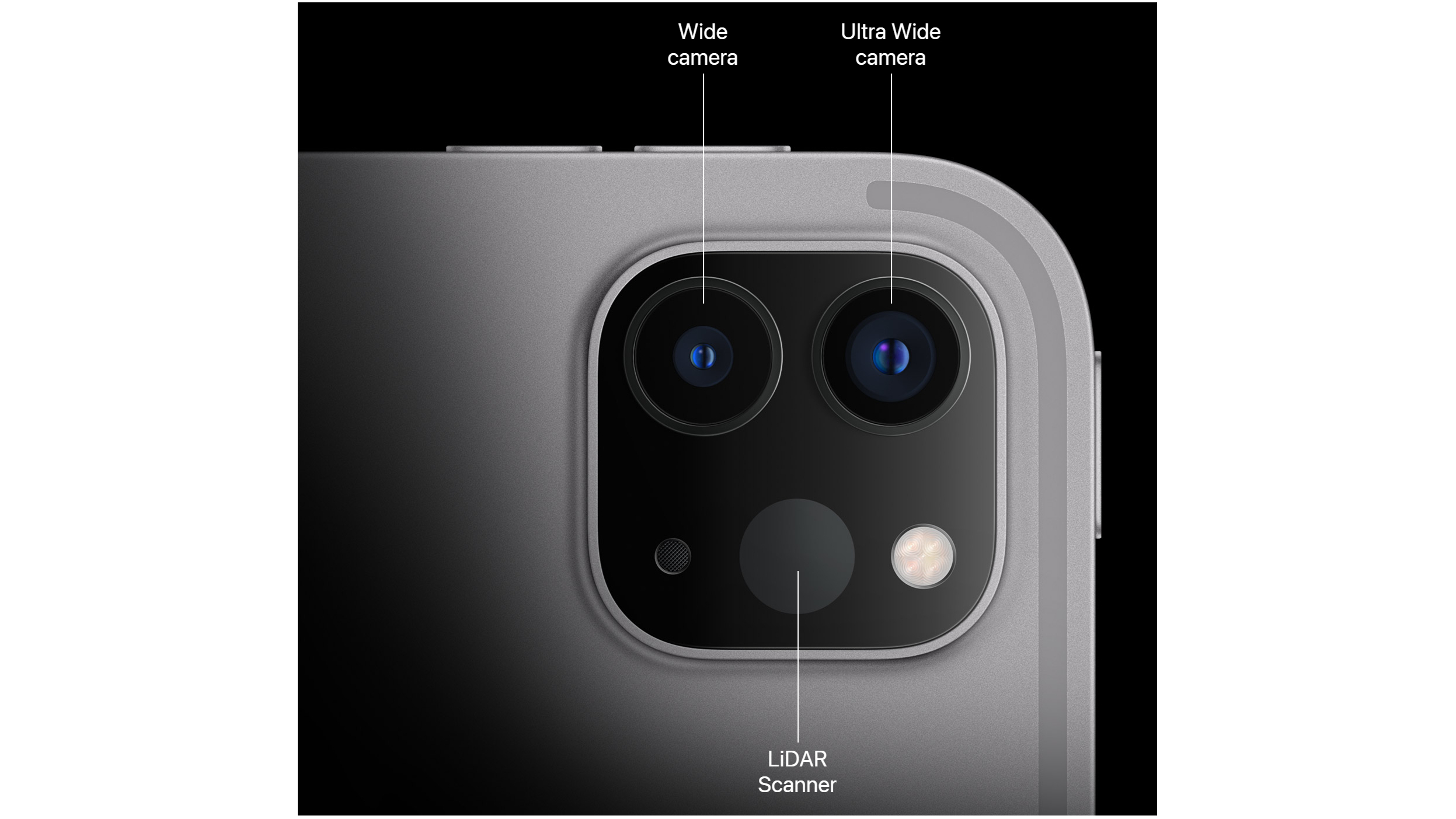
The cheaper iPad has a single wide-angle f/2.4 lens with an 8MP sensor on the back and a 12MP ultrawide on the front. By today's standards, they're both fairly basic – any mid-range smartphone can beat it. As for video, it only provides Full HD 1080p.
The iPad Pro is very different. Here, you get a dual-camera system on the back, with a 12MP f/1.8 wide-angle cam, plus a 10MP f/2.4 ultra-wide (125°) cam. They also include a LiDAR module as part of the camera system, enabling them to scan in 3D. This can be used for quicker autofocus in dark scenes, but can also be used for augmented reality applications, enabling images/video to be combined with detailed 3D data, which can then be analysed or have information added to it live by developers.
The camera tech in the iPad Pro is also more advanced – better sensors, better lenses, better image processing, so the overall image quality is vastly superior to the entry-level iPad. That includes 4K 60fps video recording (though not in HDR, sadly).
The front camera on the iPad Pro is a 12MP f/2.4 ultra-wide, with a 122° field of view. You're not supposed to use all of it, though – the reason for this is for Apple's new 'Centre Stage' feature. When you're on a video call, it detects your face and crops into the image to just show you.
If you move around, it auto pans to follow you within its ultra-wide view. If more than one person is there, it widens the field of view to accommodate that. It's clever, but it does mean you only get 1080p recording instead of 4K. The front camera also benefits from the Face ID 3D scanning system, using it to create 'Portrait mode' images.
iPad vs iPad Pro: Performance
We find the 2021 regular entry-level iPad to still be a capable portable computer for many general uses, including browsing, email, entertainment and productivity. It uses the Apple A14 chip for its processor and graphics. It'll run any app well enough for basic stuff, including photo editing and video editing, and performs well when you have apps side-by-side in Split View.
But the iPad Pros' M2 chip is really in another league. It's an eight-core CPU with 8GB or 16GB of RAM (depending on this storage size you choose), and GPU as powerful as lighter dedicated graphics chips. The A13 chip scored around 1,324 in Geekbench 5 for single-core performance, while the M2 scores around 2,644, so there's almost a 100% improvement there. When it comes to multi-core performance for really taxing tasks, the difference is even larger, with the iPad Pros providing triple the power, according to our benchmark tests.
And that isn't even the biggest performance gap. When it comes to GPU power, the A13 scores around 6,557 in Geekbench 5's Metal benchmark, while the M2 scores around 44,915. So that's more than quadruple the power for GPU computation, which includes rendering of images and effects – a huge boost for advanced creative work such as video editing in the likes of Lumafusion.
Couple this with the large amounts of RAM, the iPad Pro is on a par with many pro laptops when it comes to power. There's no question – the iPad Pro is truly pro, while the cheaper iPad is designed to be fast and capable for lighter tasks. We found that the cheaper iPad can still tackle creative tasks, but it hits a ceiling: the size of the canvas, the number of layers, the number of tracks and so on, can all cause it to stutter.
iPad vs iPad Pro: Price
The cheaper iPad starts from $329 / £369 for the 64GB model (which, frankly, you should only get if you'll do everything on it from the cloud), or you can get the 256GB version for $479 / £459. Even that could be limiting for creative work, of course, but that's all this model goes up to. If you want to add 4G support, you're looking at $459 / £519 for 64GB and $604 / £609 for 256GB. However, since the tablet is now a few years old and there's now a newer upgraded 10.9-inch iPad, there are often discounts available at third-party retailers (see current deals below).
As for the Pros, the 11-inch iPad Pro starts from $799 / £899 for 128GB of storage with 8GB of RAM. There are more configurations to choose from than with the entry-level iPad, and you can take storage right up to 2TB for $1,899 / £2,149. The 12.9-inch model starts at $1,099 / $1,249 for 128GB / 8GB, while the highest WiFi-only configuration with a 2TB SSD costs $2,199 / £2,499. In all cases, adding 5G connectivity costs around $200 on top. Again, there are sometimes discounts available, but these don't tend to be as significant as with the base iPad.
iPad vs iPad Pro: Conclusion
The cheaper iPad model has its place in a creative's toolbox – as the more budget way to show off your work on the go, its screen does a great job. As a lower-price drawing or note-taking tool, it works well. As just a video companion on your travels, it's great. But the iPad Pro definitely earns its (admittedly large) price increase. It has the power of a MacBook Pro in a pencil-thin frame. Its drawing experience is a major step up. Its screen is hugely improved, and in the case of the 12.9-inch model, is the best on any tablet, and arguably any laptop, in fact.
If you want a mobile creative powerhouse that's totally future-proofed for whatever you might need to do next, as well as what you do today, the iPad Pro is obviously the better choice. But as a media and light computer on a budget, the 10.2-inch iPad is one of the best tablets of its category.
The 10.2-inch iPad mostly finds its home as a general tablet for around the house – ideal for browsing the web, watching video, playing games and more. But it has a huge amount of creative potential itself, or could be a great tool in your bag for showing off creative work. It really depends on your work. The iPad Pros are creative powerhouses, released this year using Apple's desktop-class processor, and really staking a claim to be your primary creation tool, depending on the task.
See below for the best current deals in your area on iPad vs iPad Pro. Once you've chosen, you may want to complete your tablet with one of the best drawing apps for iPad and the best iPad keyboards.







